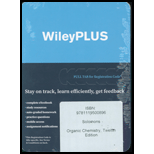
Interpretation:
The structure of phenacetin and phenetidine from the given data are to be determined.
Concept introduction:
Infrared spectroscopy is a simple, instrumental technique, which helps to determine the presence of various
It depends on the interactions of atoms or molecules with the
Infrared spectroscopy is most commonly used in the identification of the structure of the compound.
Infrared spectroscopy is the examination of the infrared light interacting with a molecule. The examination can be done in three ways, that is, by measuring absorption, emission, and reflection, and it can also measure the vibration of atoms.
Infrared absorption bands indicate the functional groups present in a compound. For example, carbonyl group shows a band from
Nuclear Magnetic Resonance (NMR) is one of the most capable analytical techniques used for determining the functional groups and how the atoms are structured and arranged in a molecule.
Few elements, such as
In
Induced magnetic field consists of electricity generated from movement in a magnetic field.
Any signal’s position on the X-axis in the
The number of signals in
The area covered by the signal is proportional to the number of equivalent protons causing the signal.
The hydrogen atom on adjacent carbon atoms splits the peak into two or more peaks. One, two, and three hydrogen atoms split the peak into two, three and four peaks, which further, is referred to as doublet, triplet or quartet.
The decrease in the electron density around a proton deshields the signal downfield at a larger value of chemical shift.
The increase in electron density shields the signal upfield at a lower value of chemical shift.
NMR data indicates the number and type of protons or carbons present in a compound based on a number of signals obtained in
Want to see the full answer?
Check out a sample textbook solution
Chapter 17 Solutions
ORGANIC CHEMISTRY-WILEYPLUS ACCESS PKG.
- Provide the missing information for each of the two following reacitons: *see imagearrow_forwardDraw an example of the following functional groups: *see imagearrow_forwardAldehydes and Ketones: Show the reaction conditions, and molecules, that connect the reactant to the product. A protecting group will be needed. *see imagearrow_forward
- Aldehydes and Ketones: Show the reaction conditions, and molecules, that connect the reactant to the product. *see imagearrow_forwardProvide the missing information for each of the four reactions: *see imagearrow_forward6. Chlorine dioxide (CIO) is used as a disinfectant in municipal water-treatment plants. It decomposes in a first-order reaction with a rate constant of 14 s. How long would it take for an initial concentration of 0.06 M to decrease to 0.02 M? [6 pts]arrow_forward
- If possible, replace an H atom on the a carbon of the molecule in the drawing area with a methyl group substituent, and replace an H atom on the ẞ carbon with a hydroxyl group substituent. If one of the substituents can't be added for any reason, just don't add it. If neither substituent can be added, check the box under the drawing area. en HO OHarrow_forwardCurved arrows are used to illustrate the flow of electrons. Use the reaction conditions provided and follow the curved arrows to draw the intermediate and product of this hydrohalogenation reaction. Include all lone pairs and charges as appropriate. Br Select to Draw 51°F Sunny esc F1 HBr Select to Draw 1,2-hydride shift Br Select to Draw Q Search F2 F3 F4 1 2 # # 3 DII L F5 F6 F tA $ % Λarrow_forwardplease help i cant find the article to even startarrow_forward
- What are the missing reagents for the spots labeled 1 and 3? Please give a detailed explanation and include the drawings and show how the synthesis proceeds with the reagents.arrow_forwardhelp with the rf values i am so confusedarrow_forwardPredict the organic reactant of X and Y that are involved in the reaction below, and draw the skeletal ("line") structures of the missing organic reactant. Please include all steps & drawings & explanations.arrow_forward
 Organic ChemistryChemistryISBN:9781305580350Author:William H. Brown, Brent L. Iverson, Eric Anslyn, Christopher S. FootePublisher:Cengage Learning
Organic ChemistryChemistryISBN:9781305580350Author:William H. Brown, Brent L. Iverson, Eric Anslyn, Christopher S. FootePublisher:Cengage Learning EBK A SMALL SCALE APPROACH TO ORGANIC LChemistryISBN:9781305446021Author:LampmanPublisher:CENGAGE LEARNING - CONSIGNMENT
EBK A SMALL SCALE APPROACH TO ORGANIC LChemistryISBN:9781305446021Author:LampmanPublisher:CENGAGE LEARNING - CONSIGNMENT Introduction to General, Organic and BiochemistryChemistryISBN:9781285869759Author:Frederick A. Bettelheim, William H. Brown, Mary K. Campbell, Shawn O. Farrell, Omar TorresPublisher:Cengage Learning
Introduction to General, Organic and BiochemistryChemistryISBN:9781285869759Author:Frederick A. Bettelheim, William H. Brown, Mary K. Campbell, Shawn O. Farrell, Omar TorresPublisher:Cengage Learning



